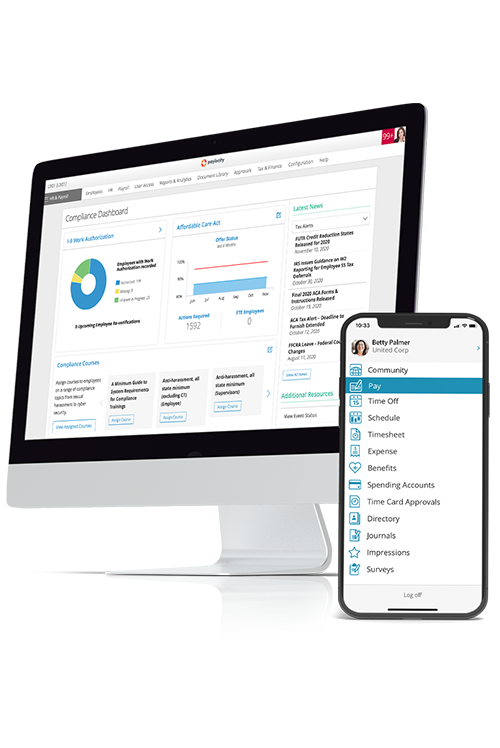resources
What Is Human Resource Management (HRM)? Importance, Functions, and Examples
March 31, 2023
Human resource management is the practice of managing your employees as efficiently and effectively as possible. Partner with us to supercharge your HRM.
Blog Post

Modern Human Resources is far more than a support role — it is increasingly a growth-driver.
Professionals working in human resource management (HRM) today are responsible for a wide array of tasks, from day-to-day administration of payroll and compliance to long-term workforce development strategy and execution.
But what is HRM exactly, and why is it essential? In this post, we’ll explore the meaning, importance, and functions of human resource management — and explain how the right software can help.
What Is Human Resource Management?
Human resource management (HRM) is the practice of managing an organization’s employees — i.e., its human resources — as efficiently and effectively as possible. This process is sometimes just referred to as HR.
Human resource management typically covers the core functions of HR, such as recruitment, compensation and benefits, training and development, and employee relations. HR pros must balance administrative duties alongside strategic business initiatives to ensure an organization has the workforce it needs to succeed and grow.
Sometimes employees are referred to as human capital. However, human resource management should not be confused with human capital management (HCM), which is a more holistic approach that covers the entire employee lifecycle within your company.
What Are the Business Applications of Human Resource Management?
Resource management, or resource planning, is an essential business function whereby organizations decide how to allocate their resources for maximum effect. In addition to things like money, equipment, and materials, resources can mean skills, time, and even people.
So, in HR terms, human resource management is about hiring the right people for the job and making use of each employee’s skills and abilities. HR professionals strive to ensure productivity by delivering proper training and maintaining a fair and ethical workplace with a positive employee experience.
What Do Human Resource Management Professionals Do?
Professionals who work in HRM use their strong interpersonal and organizational skills to get the best performance from employees. They may focus on a particular HR function, such as employee relations, payroll, recruitment, admin, or change management.
Some duties and responsibilities of HR professionals include:
- Foster company culture. One of their key skills is keeping employees engaged and motivated, which means developing a positive company culture and making sure everyone is treated fairly.
- Employee performance management and development. HR practitioners are also tasked with maintaining productivity, so performance measurement, training, and development are part of the role.
- Develop company policy and ensure compliance. The human resources management process involves creating and communicating company policies to the workforce and ensuring the implementation of safety measures and regulatory compliance.
- Strategic workforce management. HR professionals also may advise the company on layoffs or restructuring and work with labor unions.
Why Is Human Resource Management Important?
Human resource management is a crucial part of any business’s operations. Improving overall efficiency and the employee experience not only optimizes time and money but also contributes to your organization’s long-term growth.
HRM helps improve business outcomes through:
Greater workforce efficiency
HRM ensures your resources are used to their full potential by empowering employees to be more productive. It provides organizational support for other parts of the business too — for example, scheduling is made simpler when HR teams are on top of vacation and sick leave.
Streamlined talent acquisition
Effective recruitment and talent management are also part of HRM’s responsibilities. Working with hiring managers, HR determines the skills and experience required for new roles, negotiates fair compensation, and adheres to equal opportunities legislation. They make the process as smooth as possible, giving candidates a great impression from the get-go.
Improved employee management and retention
In addition to recruitment, HRM assists with retention (and all the cost savings it brings) by keeping employees motivated and engaged. By maintaining clear communication and resolving personal issues quickly, HR managers can create strategies to prevent dissatisfaction and ultimately, burnout. HRM supports the personal goals of each employee, providing ongoing training and professional development.
Data-powered strategies
HR teams can also bring to bear the power of data to help businesses make smarter decisions. Where are there performance lags? How well are staff engaged? Modern HR software helps answer those questions at a glance.
Human Resource Development vs. Human Resource Management
Acronyms are pervasive in the world of HR. Meet HRD, a.k.a. human resource development.
There are some similarities between HRM and HRD — they both involve problem-solving, for example — but HRD is actually a part of human resource management rather than a separate practice.
While HRM is a broad field that encompasses workforce relations, recruitment, benefits, and compliance, HRD has a specific focus on nurturing each employee’s personal and professional growth — and aligning their development with company goals.
In a larger organization, there may be a dedicated HRD team that includes training specialists, instructional coordinators, and program developers. They create initiatives to help employees with career advancement, which increases retention and improves learning and performance across the company.
Human Resource Management Responsibilities
The responsibilities of human resource management teams are many and varied. Here are just some of the tasks carried out by HR professionals.
Policy Creation
Human resources management includes developing and revising policies and protocols on everything from health and safety to dress codes and disciplinary action. HR teams consult with other managers before writing this documentation and communicating it to the whole company.
Staffing and Recruitment
Managing recruitment means that HR managers have to be aware of the budget for hiring new employees. The role involves posting job ads, processing applications, and interviewing qualified candidates, maintaining regular communication throughout the process. HR managers also negotiate salaries and benefits and carry out onboarding.
Pay and Benefits
HR professionals help create a fair pay system based on experience, skills, length of service, and industry standards. They recommend pay increases, negotiate benefits packages, and make sure everyone receives their pay and expense reimbursements on time. They also help employees understand their paychecks, including taxes and contributions.
Employee Relations
Keeping employees satisfied with their work environment is a major part of HRM. This includes addressing any concerns over pay, equipment, or workload; resolving conflicts, and responding to grievances.
HR managers work hard to maintain healthy workplace relationships and develop a positive culture. They may arrange team-building activities and social events.
Evaluation and Training
HR staff monitor employee performance and deliver constructive feedback, as well as collect data to inform decisions on raises, promotions, and dismissals. They ensure top performers are recognized and rewarded, provide skills training for career advancement, and keep all employees up to speed on compliance policies.
Compliance
HR teams ensure all company policies comply with relevant legislation on things like equality, pay and benefits, working hours, and safety. They typically create an employee handbook or official document that clearly outlines these policies and update it as legislation evolves.
In addition to looking after employees’ physical and mental health, HR teams are also responsible for protecting their personal information.
Advantages of Using a Human Resource Management System
It’s plain to see that modern human resource management has a lot of moving parts. And manual methods just don't cut it.
Human resource management software helps standardize your HR processes and automates many of the tasks that take up time and eat into productivity.
For example, you can create custom workflows for regular tasks and set up templates for documentation. HRM software also streamlines communications, both internally and with job applicants, while also providing a wealth of data about your workforce
Other benefits for recruitment include the automatic posting of job vacancies on multiple sites, resume screening, and automated onboarding processes such as sending out login details and delivering training sessions.
Automation reduces the risk of errors and compliance issues, and it definitely pays off: Deloitte recently found the average company wastes $24,000 annually because of a lack of HR automation.
The best HRM systems come with an employee self-service portal that enables workers to access and update their own records, view paychecks, request time off, and submit expense claims. Your HR team can quickly approve vacation requests and keep track of employee attendance with a real-time overview of who’s working at any given time.
Read More: What is Employee Self-Service (ESS)?
Examples of Human Resources Management Solutions
In the early days of HRM technology, your software system would have been housed on-premises. That’s still the case for some businesses today, but many organizations are now moving over to cloud-based software-as-a-service (SaaS) platforms, which are more scalable and cost-effective than legacy systems.
SaaS solutions are owned by your vendor, who takes care of all maintenance and updates. You effectively rent the software with a monthly subscription, so there’s no upfront capital investment and you can easily add or remove users or features when needed.
SaaS Human Resource Management Solutions
Within the category of SaaS for HR, there are several options, including Human Resource Information System (HRIS). This was the original software solution for human resources. Although it digitizes workflows and records, HRIS software is more about managing administrative tasks than enhancing the employee experience.
Human resource management systems (HRMS) were created to add an extra layer to HRIS, with tools for handling onboarding, training, and well-being. This is a more robust option than HRIS, but doesn’t offer the full benefits of an integrated Human Capital Management system like Paylocity.
While HRMS software aligns with the tactical approach of HRM, a Human Capital Management (HCM) solution allows you to create a better experience through every phase of the employee lifecycle. This includes helping staff feel connected through informal communication, peer recognition, feedback, and self-service options.
HCM software is typically a flexible platform with broad functionality. It automates core processes like payroll but also supports talent and workforce management with features like recruitment, onboarding, learning, and time and expense management. An HCM system also includes reporting and analytics to help identify trends and connect data to business objectives.
Read More: HCM vs. HRIS vs. HRMS: What Are the Differences?
Supercharge Your HRM with Paylocity
HRM is an integral part of running a business. It makes sense, then, to invest in a robust integrated HCM solution that combines critical functions like payroll administration with tools to improve the employee experience.
Paylocity is a customizable, all-in-one solution that helps HR professionals manage every aspect of the employee lifecycle. It’s designed to streamline and simplify processes, giving HR teams more time to focus on people, while also breaking down silos across the organization.
Collaboration tools like Paylocity’s online social hub, Community, help employees connect through chat and peer recognition, while employee self-service capabilities empower them to manage their time, finances, and personal information.
Paylocity’s also includes built-in reporting features that provide a holistic view of your workforce, giving HR teams valuable data to inform business decisions from staffing to succession planning.
Frequently Asked Questions about HRM
Who Is Responsible for Human Resource Management?
Your HR team is responsible for human resource management. In smaller businesses, this team may be made up of general HR professionals, who each cover a wide range of HR tasks. A larger organization with a more extensive HR department may split the process into specific roles.
So, you might have managers who are responsible for areas like payroll and benefits; recruitment and onboarding; talent management and retention; workforce and performance management; training and development; diversity, equity, inclusion, and accessibility (DEIA); compliance; and employee engagement.
What Is a Human Resource Management System?
A human resource management system (HRMS) is a software solution that streamlines and standardizes HR processes, from recruitment and training to payroll and compliance. An HRMS typically enables the automation of manual tasks and keeps all your documentation in one place.
HRMS software is set up for strategic human resource management, but you can enhance the employee experience by upgrading to a human capital management (HCM) system for a more holistic approach to HR.
What Is the Difference Between HR and HRM?
HR stands for "human resources" and HRM stands for “human resource management." HR is generally used to define the people or department that work on HRM-related initiatives that affect the entire employee lifecycle.




